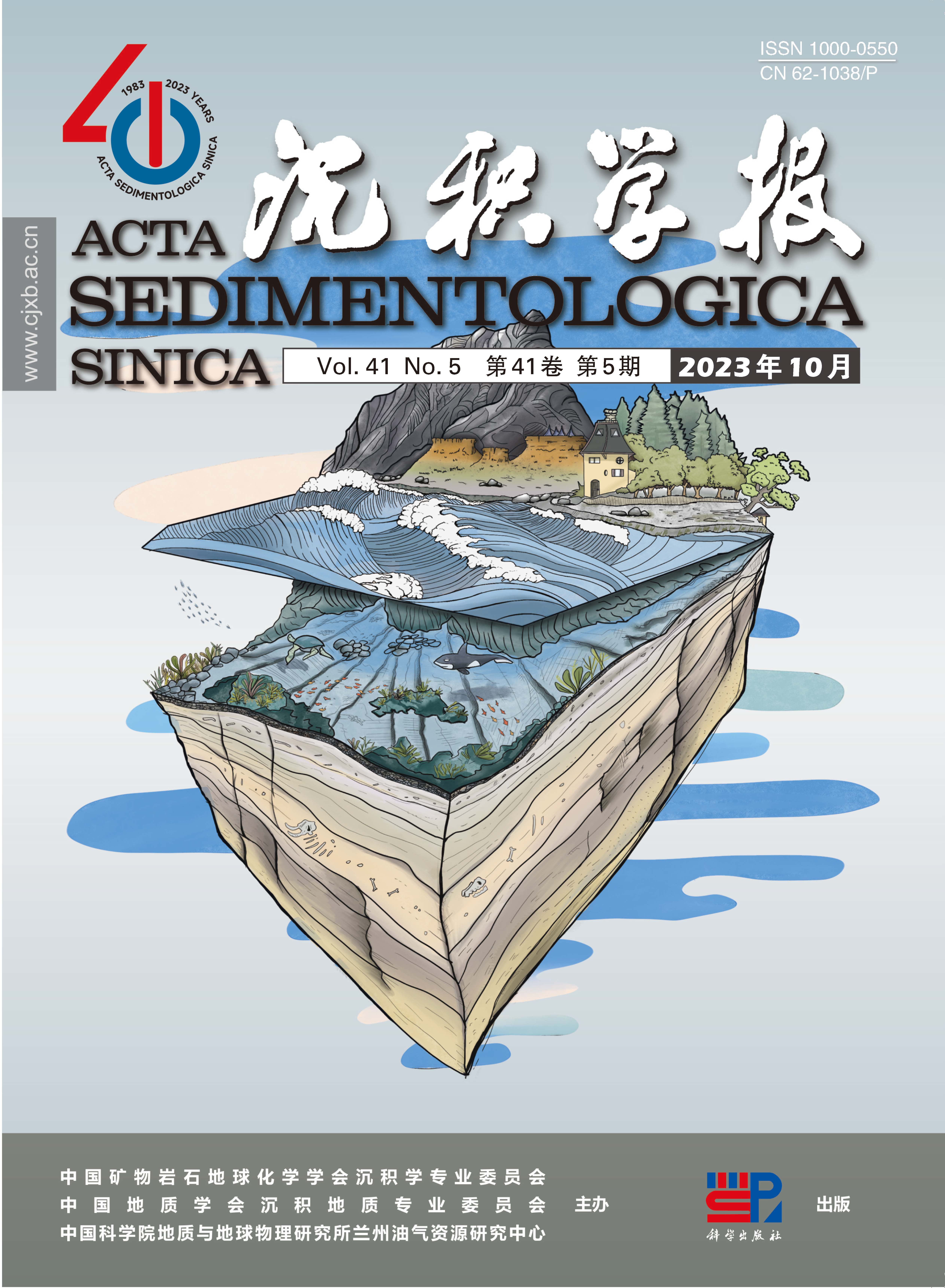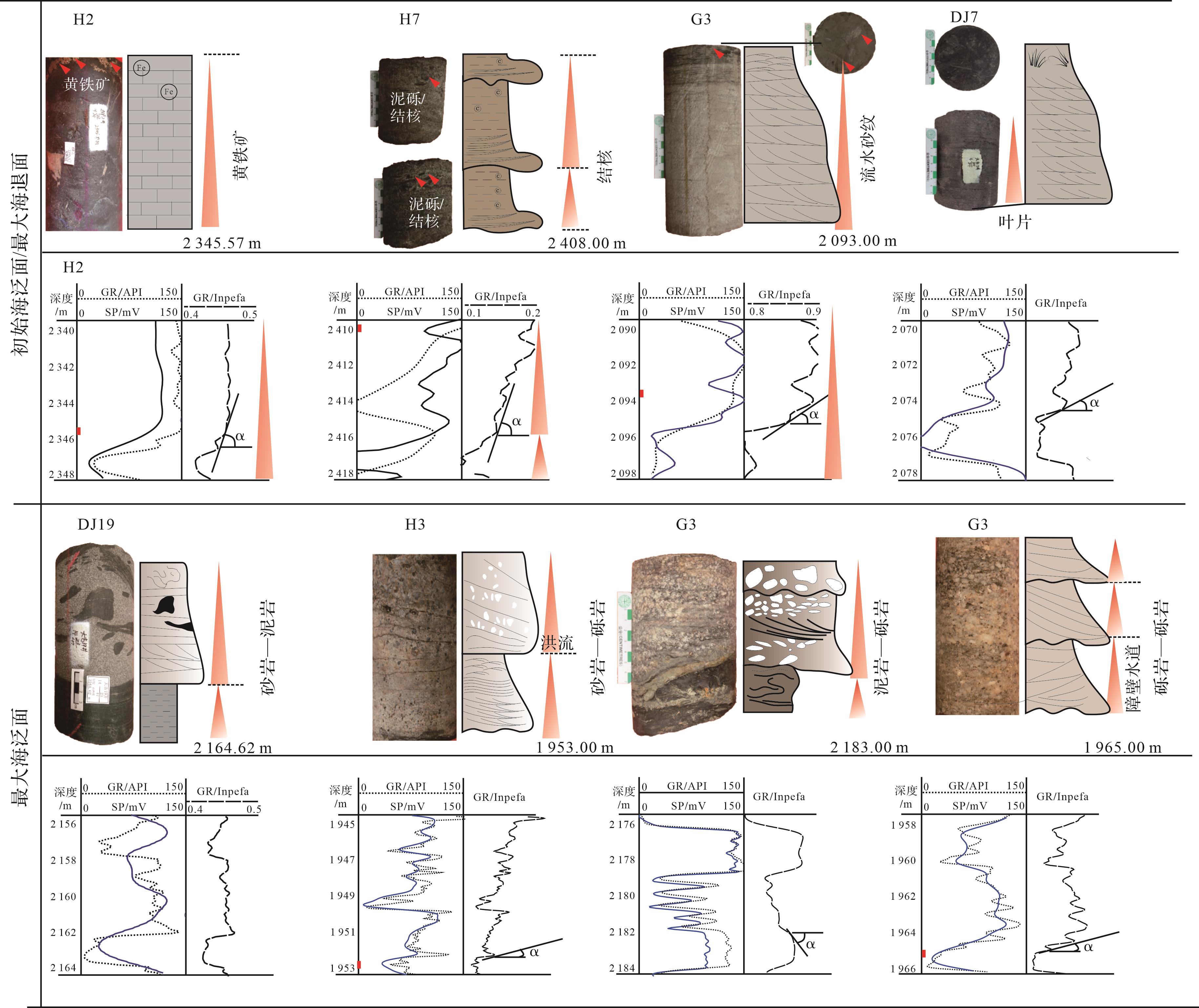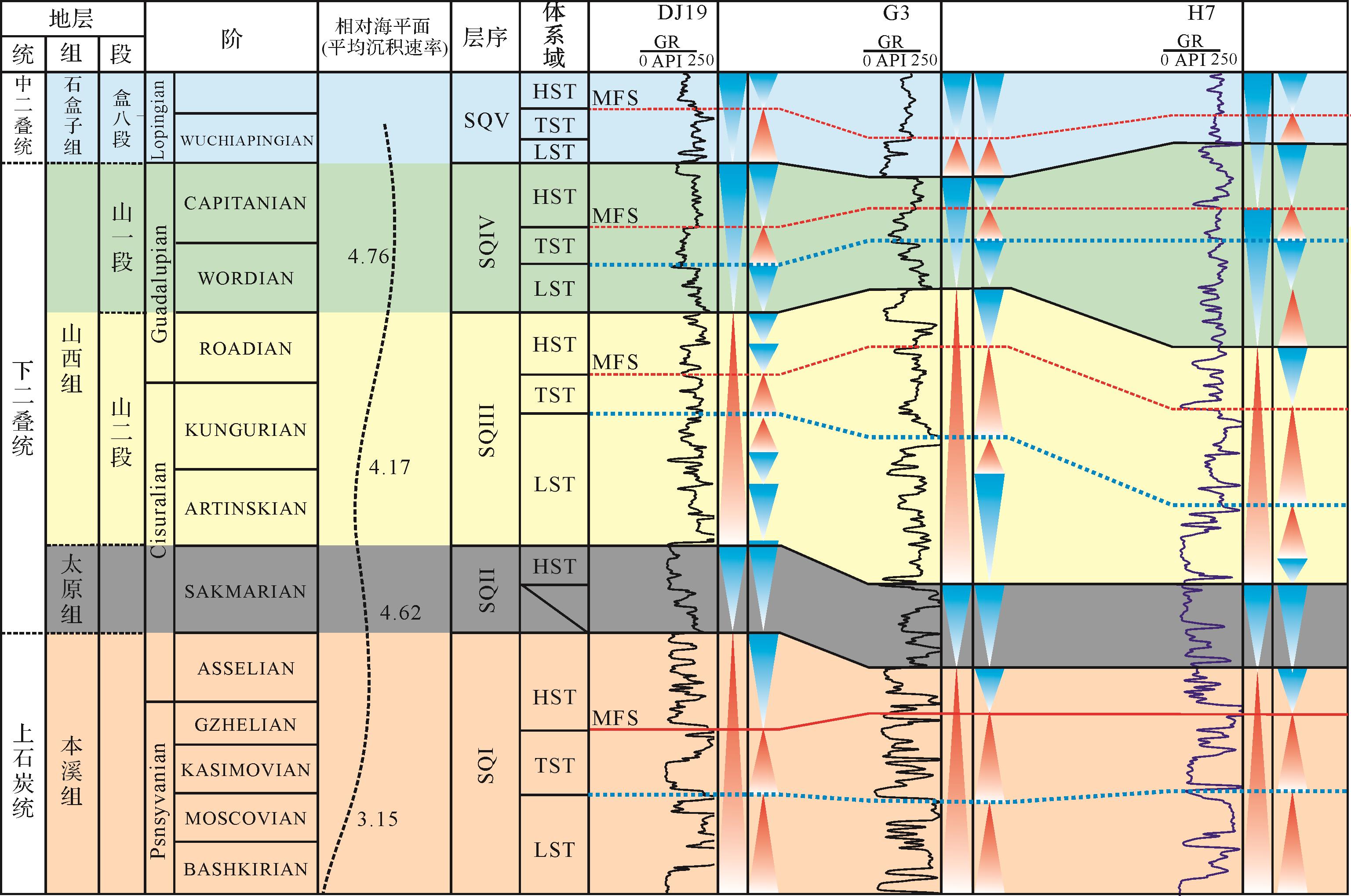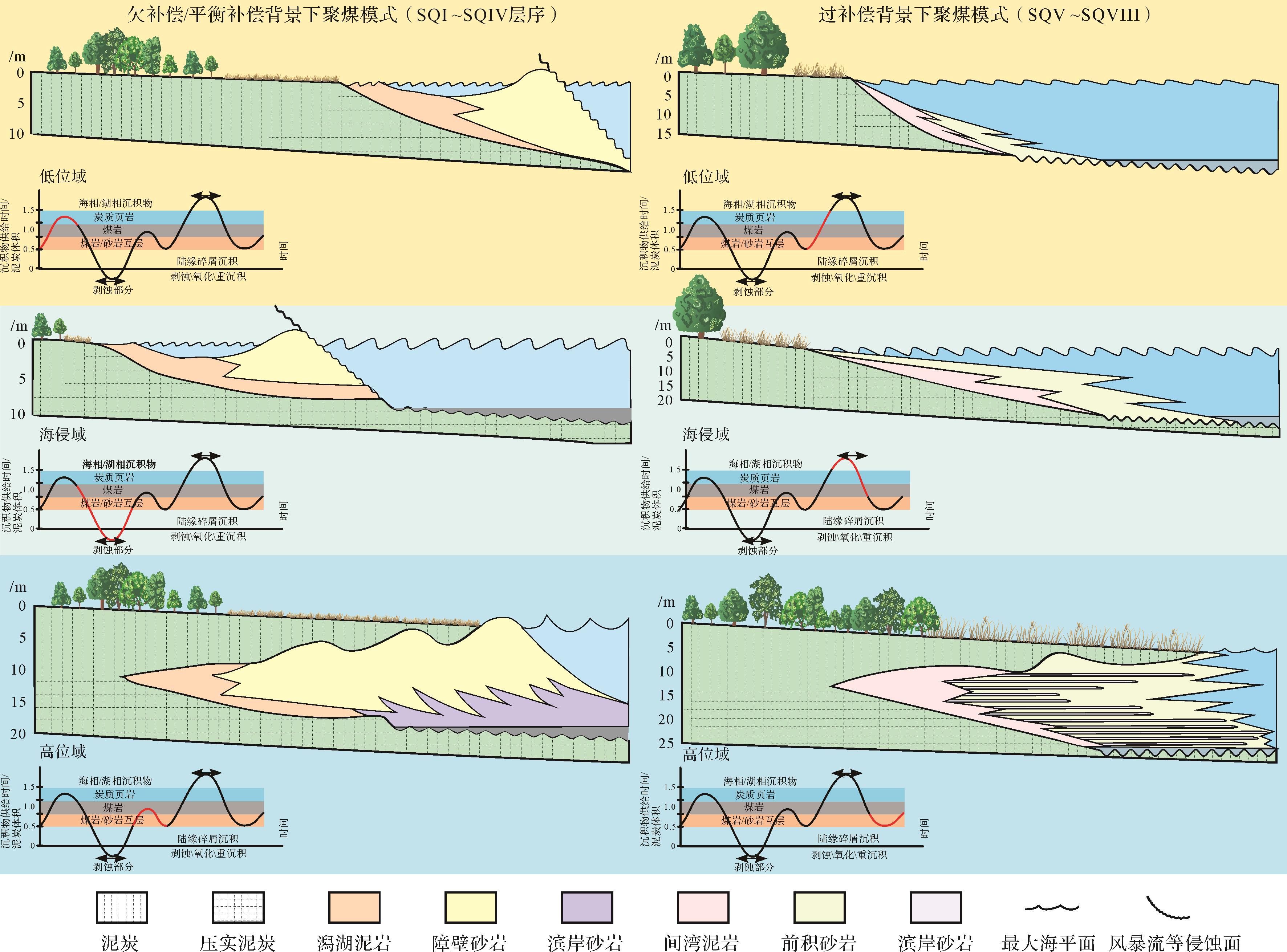HTML
-
陆表海沉积的研究起源于Witzke[1],其层序以发育海侵域和高位域为主,低位域缺失的特点,通常较高的海平面可以为泥炭保存提供封闭的环境。同时,陆表海主要发育浅水三角洲或滨—浅海障壁沉积,局部洼地可以为泥炭沼泽提供较为理想的聚集空间[2⁃5]。但是,陆表海沉积不同于河流主控的沉积体系,其受到波浪和潮汐改造更加频繁[6⁃8],造成沉积物难以有效保存,进而使其研究存在一定的难度。近些年陆表海沉积环境中主控因素、动力学背景、聚煤作用和砂体形态等方面已经成为研究的热点。
本次研究区域为鄂尔多斯盆地东南部,位于华北地台西部,在晚古生代期间经历了剧烈的海退和气候逐渐干旱过程[9],为陆表海含煤层系的层序地层学研究提供了较好的研究对象。对于含煤层系层序地层学的研究,最早开始于Jones[10]和Collinson et al.[11],主要关注海平面变化对聚煤规律的影响,即正常海侵和海退与聚煤间的相互作用。但该模式无法解决滨—浅海区域快速海退背景下区域聚煤成因复杂的问题。同时,在研究含煤层系层序地层发育的影响因素方面[12⁃13],目前研究更多从定性角度刻画海平面变化和物源供给等因素,缺少定量刻画方法,即无法为陆表海聚煤背景下层序划分提供可操作性的方案[9]。
此外,华北地台晚古生代处于冰期和间冰期转化的阶段[14⁃16]。早期研究主要探讨该区域体系域的识别和其沉积演化过程[17⁃21],而最近研究则多关注不同含煤层系层序样式的建立与定量表征其演化过程[22]。本次研究采用为Catuneanu et al.[23⁃24]提出的层序标准化之后的格架划分方案,结合Vail et al.[25]提出的可容纳空间、基准面等概念[25],将沉积物供给和海平面变化两者结合进行综合分析。针对晚石炭世—早二叠世滨浅海环境和三角洲背景下对鄂尔多斯东部不同层序背景下聚煤模式进行分别论述。
-
鄂尔多斯盆地四周均为造山带所围,东边吕梁山,西边贺兰山—六盘山,北面阴山、阿拉善古陆,南面秦岭(图1)。盆地内部断裂较少,研究区所处鄂尔多斯盆地东南部,研究区总面积为2 395 km2,在构造单元划分中属于晋西挠褶皱带,其早古生代主要为陆表海沉积[9]。

Figure 1. Geological map of Ordos Basin and comprehensive histogram[9]
鄂尔多斯盆地沉积物总厚度最大为10 km,盆地充填以显生宙沉积物为主。该盆地由于受到加里东运动影响,盆地抬升,古生界地层缺失上奥陶统—下石炭统约160 Ma沉积记录,其中下古生界地层厚300~600 m,上古生界厚约900 m。中生界和新生界地层发育较为齐全,仅上白垩统地层缺失,中生界地层厚约5.5 km,新生界地层厚约3 km。晚古生代主要发育上石炭统—下二叠统太原组,下二叠统山西组,中下二叠统下石盒子组,上二叠统上石盒子组。该时期为典型的陆表海沉积环境[9]。
-
现代层序地层学等时研究的前提是识别层序界面,然而由于研究区地形相对平缓,岩性变化不明显,难以有效地确定含煤层系的层序界面,亟需引入多种参数进行综合划分。Banerjee et al.[26] 提出利用岩相、地化数据、孢粉等指标的递变划分含煤层系的垂向层序。Catuneanu[24]指出利用地球物理响应差异划分层序。本次研究首先综合上述提及的多种指标(地化、粒度、电性特征)识别出短期层序(0.5~3 Ma);在此基础上将短期层序进行组合,建立中期层序(1.5~5 Ma)。
-
对于单井短期旋回的划分主要参考其粒度与测井值的变化。根据自然伽马(GR)曲线和GR-Inpefa曲线的变化趋势确定出基准面的变化方向。其中GR-Inpefa测井曲线为利用频谱分析手段,将测井曲线的细小信息进行放大,使其识别精度达到米兰科维奇层序划分的要求。GR-Inpefa曲线,斜率为正代表海平面上升,斜率为负代表海平面下降,局部凸点代表海平面的突然变化。
Johnson et al.[27]提出将一次水体加深过程和一次水体下降过程合并为一个完成的层序的理论(T-R层序划分理论)。基于该理论,本次研究需要识别出初始海泛面(FS)和最大海退面(MRS)、最大海泛面(MFS)。初始海泛面和最大海退面以暴露作为主要的识别标志,其中包括钙质结核、干裂纹、瘤状植物和根土岩等。此外,由于风化、淋滤和改造等作用导致其下伏岩性存在一定的差异[26⁃28]。因此,GR曲线表现出较为明显的突变,即通过突变最明显的转折点确定其层序边界(图2)。最大海泛面主要表现为沉积供给量减少导致的沉积间断[27],在垂向上表现为粒度向上变细、沉积构造规模变小的特点[9,28⁃29]。
-
通过对岩石物理性质分析,识别出煤层和灰岩等阻抗差异较大界面。如利用太原组顶部全区广泛发育的东大窑灰岩Tc2,作为SQIII底界面[30]。将山西组中4+5#煤层发育的层位确定为Tp10,为最大海泛面。同时利用上超、下超和削截等界面接触关系进行确定,进而将晚古生代早期(巴什基尔阶—吴家坪阶)划分出5个层序:SQI~SQV。SQI以最大海退面(MRS)为底界,与下伏的奥陶系灰岩层呈现角度不整合,该时期整体基准面上升,层序厚度变化不大。SQII时期,存在沉积中断(hiatus)沉积物供应减少,故低位域不发育[31⁃33]。而在高位域以碳酸盐岩台地沉积台地为主。SQIII、SQIV和SQV均以最大海退面(MRS)为层序的边界,具有完整的旋回结构(LST-TST-HST)(图3)。

Figure 3. Stratigraphic division at the eastern margin of the Ordos Basin (Late Carboniferous⁃Early Permian)
从地震反射特征来说(图4),由于研究区地震资料分辨率有限,因此难以识别出明显的沉积体边界。因此主要利用同相轴的叠置关系,判断可容纳空间和沉积物供给速率之间的关系:当同相轴为连续高振幅时,反映可容纳空间变化速度≈沉积物供给速度;当可以识别出明显的前积同相轴时,反映可容纳空间变化速度>沉积物供给速度;当可以识别出明显的同相轴削截时,反映可容纳空间变化速度小于沉积物供给速度。此外,为了克服地震分辨率有限的问题,沿地震测线建立连井砂体对比剖面,辅助其层序界面的刻画与沉积充填过程的刻画(图5)。
SQI地震同相轴连续性较好,但地震强度中等,斜坡上游连续性强于下游。参考Diessel et al.[29]提出的欠补偿盆地、平衡盆地和过补偿盆地中的层序样式。SQI时期为平衡补偿的层序样式,即基底沉降速率与沉积速率相近,低位域与高位域都有沉积物发育。SQII上部灰岩同相轴较为连续,底部同相轴具有明显的叠覆现象。解释为陆坡中部具有大量的沉积物聚集,在高位域时期沉积物发育有限。SQIII~SQV中部同相轴连续性高和极性较强,推测为最大海泛面(MFS),多发育细粒沉积。MFS上部同相轴可见少量削截,对应海退过程暴露过程。MFS下部可见大量的同相轴丘状隆起,对应低位楔沉积。
-
上述识别的层序在垂向上可以划分出不同类型的叠加样式,其中按照单期层序的发育厚度,将其分成欠补偿背景与过补偿背景两种层序叠置样式:欠补偿条件下的层序叠加样式单期旋回较薄,GR曲线表现出脉状。多是由于沉积物供给量有限,海/湖平面频繁变化形成的。过补偿背景下的层序叠置样式短期旋回的厚度大于5 m,GR曲线表现出箱状或钟(或漏斗)状,反映上升和下降旋回中沉积物持续稳定供应过程(图6)。为了明确区分出不同补偿条件下旋回叠置样式的沉积成因差异,利用进积或退积过程进行描述。对于低可容纳空间来说,其沉降速率有限,因此可容纳空间的变化主要取决于海平面的进退。即认为进积过程为海平面下降,可容纳空间减小,基准面下降;而退积过程为海平面上升,可容纳空间增加,基准面上升。
此外,欠补偿背景下海平面变化对沉积体的影响较大。参考Fu et al.[4]研究,该背景下沉积体多发育曲流水道。根据短期旋回的叠加样式,将该背景下旋回叠置样式分成三种类型:对称型旋回,退积型旋回和进积型旋回。其中对称型旋回,主要为曲流水道弯曲度增加造成的,而进积或退积型旋回的沉积样式多对应水道弯曲程度的变化。过补偿背景主要反映沉积物供给差异对沉积体的影响,同样可以划分为对称、进积为主,退积为主三种类型。三种层序叠加样式在平面上表现为辫流水道的摆动和相互侵蚀[4]。对称型主要反映可容纳空间足够,沉积物通量较大时期形成的层序样式,多表现为双向摆动的辫状河;进积型反映可容纳空间有限,但是沉积物供给量较大,河道以下切过程为主,辫流水道摆动幅度较小;退积型反映可容纳空间增加,同时沉积物通量逐步减小,其多表现为单向摆动的辫状河,局部存在辫曲过渡沉积。
2.1. 单井层序边界识别
2.2. 井—震层序界面识别
2.3. 井—震层序叠加样式
-
基于二维地震资料和局部三维层位数据,在完成去剥蚀和去压实校正后,建立SQI~SQV时期的古地貌样式(图7)。研究区地形整体相对平缓,但是局部存在低幅隆起。参考Zhang et al.[30]和Zhu et al.[34],认为该时期由于受到华南板块的持续挤压运动,导致鄂尔多斯盆地东南部存在局部抬升现象。
从垂向演化来说,研究区早期(SQI)地形相对平坦,整体高程相对不大;SQII时期,受局部隆升作用影响,地形坡度逐渐增加,造成该时期整体高程差异较大;SQIII~SQV随着沉积充填造成的填平过程使研究区地形趋于平缓,地形高差逐步下降。
从平面展布来说,SQI时期(图7a),地形呈现东高西低的特点,并且在局部存在构造高值。SQII时期(图7b)北部隆起使地层尖灭向呈现NE向展布规律,同时东西区域开始出现不同,研究区东部为平坦的台地,西部为局部隆起的地貌。SQIII~SQV时期古地貌(图7c,d)主要为继承性发展。西部隆起区呈现明显的高低间互的特征,按照Zhang et al.[30]对山西组的研究,认为研究区的构造低值沿NW方向,是由于该方向持续沉积侵蚀造成的。总体来说研究区东部构造幅度变化较大,西部较为平坦。
-
基于上述古地貌的研究,绘制出不同层序下沉积展布。确定了4种类型的短期层序:持续进积型层序、持续暴露型层序、沉积转化型层序和对称发育型层序。其中持续进积型层序(SQIII和SQIV)主要发育中厚煤层,受地形影响较大(山1段对应4#煤);持续暴露型层序发育煤层较薄,分布范围有限(山2段底部薄煤层);沉积转化型层序(SQII),沉积供给方向不断变化,导致煤层局部尖灭较为严重(太原组8#煤,9#煤);对称发育型层序发育较厚煤层,平面分布广泛(山2段对应5#煤)。
依据Catuneanu[35⁃36]、Posamentier et al.[37]、Hubb ard[38]、Shao et al.[39]、Diessel et al.[29]和Holz et al.[9]提出的缓坡层序模型,其不存在明显的陆架破折,进而增加了对沉积体范围准确统计的难度。本次参考Posamentier et al.[37]提出的统计方法,认为前积层倾角差异反应不同期次的前积过程。统计层序的厚度(T)和倾角(α)。其中层序的厚度(T)反映可容纳空间变化量(A),倾角(α)和沉积物供给量(S)成正比。
结合层序SQI~SQIV中上述几何参数的变化,将其归纳为不同类型的层序模式。(1)SQI时期,厚度向下游逐渐减薄,倾角也由0.5°增加到1.5°,认为沉积物主要堆积在上斜坡,处于浪基面附近(图8a);顶积层和前积层均发育,厚度整体均匀;按照Posamentier et al.[37]模式,其属于持续暴露型层序。(2)SQII厚度向下游逐渐增大,其倾角也由0.8°增加到1.5°,其造成缓坡中沉积物主要集中在下游区域;依据Jiang et al.[32]对太原组时期的沉积的研究,指出由于局部存在构造隆升,导致沉积物主要在斜坡下游,故其顶积层厚度较薄,易发育台地[32⁃33](图8b)。该时期可以归为沉积转化型层序。(3)SQIII~SQIV厚度相对稳定,其倾角也相对稳定为1°~1.5°,依据Posamentier et al.[37]的模式推测,高位域和低位域较为发育,而海侵域则发育局限(图8c,d)。可以归为持续进积型层序。
3.1. 古地貌展布的重建
3.2. 层序参数定量统计
-
尽管Summerhayes[40]和Hubbard[38]在研究聚煤演化时指出该过程一般来说是穿时的[38,40]。但是,按照Catuneanu[24]提出层序尺度概念,当聚煤过程小于的三级层序对应的尺度(3 Ma),同时长于四级层对应的尺度序(300 Ka),其在层序地层学研究中认为是等时的[23]。参考Shao et al.[39]和Diessel et al.[29]提出的层序格架下聚煤模式,即综合考虑沉积物体积(Qclassics)和泥炭供给量(Qpeat)间的关系[29,39]。其中泥炭供给量由于植物数量乘以转化率(receptor ratio)得到。根据其与沉积物供体积比值的大小,可以将鄂尔多斯盆地东缘的层序格架内的聚煤模式归纳为可容纳空间主导型聚煤模式(SQI~SQII)和沉积物供给量主导型聚煤模式(SQIII~SQIV)两种类型。
SQI~SQII时期(图9)沉积物供应量有限,为欠补偿或平衡补偿背景下聚煤模式。同时受到海水改造作用较强,在强水动力区域难以聚集泥炭,因而在低位域和海侵域时期均形成明显的侵蚀界面。而对于障壁岛内侧或者局限台地一侧,由于受到外部的水动力影响较小,同时大量的有机物质进入潟湖,经过泥炭化作用形成泥炭沼泽,最终完成聚煤。故在低位域和海侵域时期聚煤作用主要发育在障壁内侧,煤层较厚,但发育规模有限。进入高位期(图9),波浪侵蚀作用较为局限,改造作用较弱,泥炭主要为继承性发育。
SQIII~SQIV时期为过补偿背景下聚煤模式(图9),该时期沉积物碎屑供源为主,低位域和海侵域时期主要发育大量的前积楔。泥岩主要发育在河流间湾的沼泽地区(interdistributary mires)。同时,受快速海侵和海退影响,泥炭遭受较为强烈的改造。在垂向上表现为中薄层煤层互层发育。在高位域时期,该时期沉积物发育较为广泛,而海平面影响范围有限。故可容纳空间(A)较大,但是增量较小,A值与S持续动态平衡,因此该模式下高位域泥炭发育规模较大。
-
(1) 从地震界面、单井和岩心出发,将鄂尔多斯东南部晚石炭世—早二叠世划分为五个层序,SQI~SQV。其中SQI为平衡补偿环境下层序,SQII为欠补偿环境下层序界面,SQIII~SQV为过补偿环境下层序发育界面。
(2) 恢复SQI~SQV不同时期对应的古地貌展布图,提出三种缓坡层序样式的划分方式:持续暴露型层序(SQI),沉积转化型层序(SQII)和持续进积型层序(SQIII~SQV)。
(3) 结合控制泥炭聚集的因素(沉积物和植物繁盛程度),将层序按照聚煤成因进行分类,早期SQI~SQII为欠/平衡补偿背景下聚煤模式,可容纳空间主导,而后期SQIII~SQV为过补偿背景下聚煤模式,沉积物供给主导。对比两种模式,可容纳空间主导型层序格架下,聚煤过程较为持续,但是发育范围局限;对于沉积物供给型主导型层序格架,聚煤过程容易受碎屑物质干扰而中断,因此形成薄煤层,但是分布范围较广。














 DownLoad:
DownLoad:







